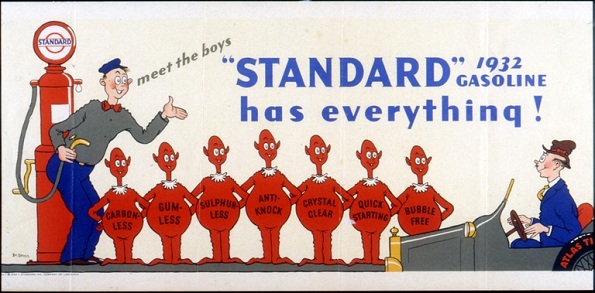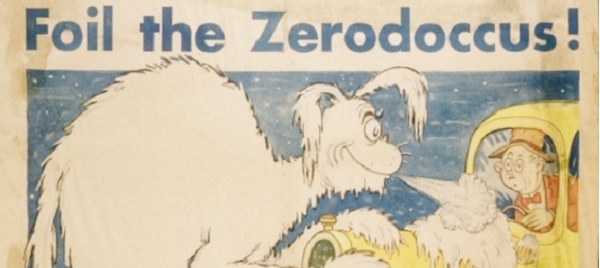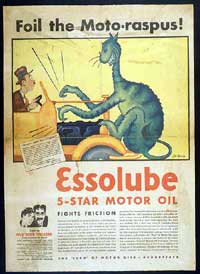This Week in Petroleum History: January 8 – 14
January 8, 1903 – Sour Lake discovery leads to Texaco –
Founded a year earlier in Beaumont, Texas, the Texas Company struck oil with its Fee No. 3 well, which flowed at 5,000 barrels a day, securing the company’s success in petroleum exploration, production, transportation and refining.

A monument marks the site where the Fee No. 3 well flowed at 5,000 barrels of oil a day in 1903, helping the Texas Company become Texaco.
“After gambling its future on the site’s drilling rights, the discovery during a heavy downpour near Sour Lake’s mineral springs, turned the company into a major oil producer overnight, validating the risk-taking insight of company co-founder J.S. Cullinan and the ability of driller Walter Sharp,” explained a Texaco historian.
The Sour Lake field — and wells drilled in the Humble oilfield two years later — led to the Texas Company becoming Texaco (acquired by Chevron in 2001). Learn more in Sour Lake produces Texaco.
January 9, 1862 – Union Oil arrives in England during Civil War
The Elizabeth Watts arrived at London’s Victoria dock after a six-week voyage from Philadelphia. The brig carried 901 barrels of oil and 428 barrels of kerosene from Pennsylvania oilfields. It was the first time America exported oil. Within a year, Philadelphia would export 239,000 barrels of oil. The United States first imported oil in 1948.
January 10, 1870 – Rockefeller incorporates Standard Oil Company
John D. Rockefeller and five partners incorporated the Standard Oil Company in Cleveland, Ohio. The new oil and refining venture immediately focused on efficiency and growth. Instead of buying barrels, the company bought tracts of oak timber, hauled the dried timber to Cleveland on its own wagons, and built its own 42-gallon oil barrels.
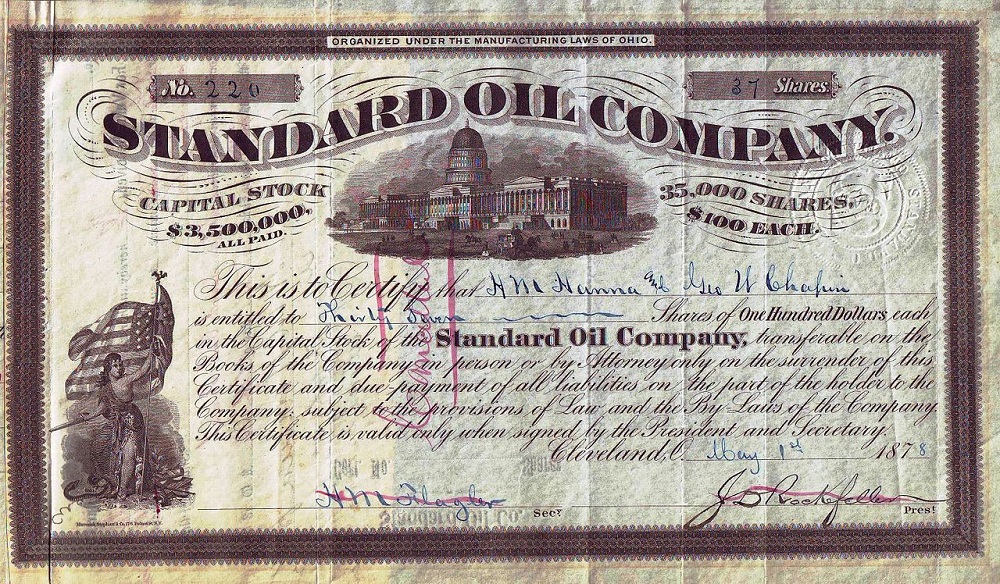
A stock certificate issued in 1878 for Standard Oil Company, which would become Standard Oil of Ohio (Sohio) following the 1911 breakup of John D. Rockefeller’s oil monopolies.
Standard Oil’s cost per wooden barrel dropped from $3 to less than $1.50 as the company improved refining methods to extract more kerosene per barrel of oil (there was no market for gasoline). By purchasing properties through subsidiaries, dominating railroads and using local price-cutting, Standard Oil captured 90 percent of America’s refining capacity.
January 10, 1901 – Texas Well launches Modern Oil Industry
The modern U.S. petroleum industry began 123 years ago on a small hill in southeastern Texas when a wildcat well erupted near Beaumont. The Spindletop oilfield, which yielded 3.59 million barrels of oil by the end of 1901, would produce more oil in one day than all the rest of the world’s oilfields combined.
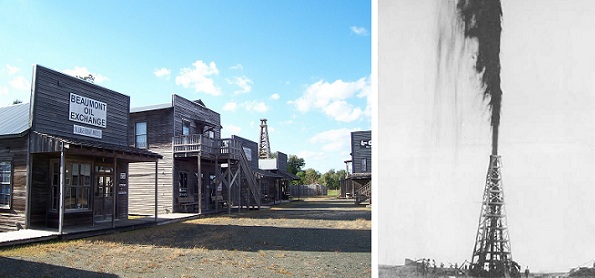
The Spindletop-Gladys City Boomtown Museum in Beaumont, Texas, opened in 1976 to educate visitors about the importance of the 1901 “Lucas Gusher.”
The “Lucas Gusher” and other nearby discoveries changed American transportation by providing abundant oil for cheap gasoline. The drilling boom would bring hope to a region devastated just a few months earlier by the Galveston Hurricane, still the deadliest in U.S. history. Petroleum production from the well’s geologic salt dome had been predicted by Patillo Higgins, a self-taught geologist and Sunday school teacher.
Learn more in Spindletop launches Modern Petroleum Industry.
January 10, 1919 – Elk Hills Oilfield discovered in California
Standard Oil of California discovered the Elk Hills field in Kern County, and the San Joaquin Valley soon ranked among the most productive oilfields in the country. It became embroiled in the 1920s Teapot Dome lease scandals and yielded its billionth barrel of oil in 1992. Visit the “Black Gold” exhibits of the Kern County Museum in Bakersfield and at the West Kern Oil Museum in Taft.
January 10, 1921 – Oil Boom arrives in Arkansas
“Suddenly, with a deafening roar, a thick black column of gas and oil and water shot out of the well,” noted one observer in 1921 when the Busey-Armstrong No. 1 well struck oil near El Dorado, Arkansas. H.L. Hunt would soon arrive from Texas (with $50 he had borrowed) and join lease traders and speculators at the Garrett Hotel — where fortunes were soon made and lost. “Union County’s dream of oil had come true,” reported the local paper.
The giant Arkansas field would lead U.S. oil output in 1925 — with production reaching 70 million barrels. Learn more in First Arkansas Oil Wells.
January 11, 1926 – “Ace” Borger discovers Oil in North Texas
Thousands rushed to the Texas Panhandle seeking “black gold” after the Dixon Creek Oil and Refining Company completed its Smith No. 1 well, which flowed at 10,000 barrels a day in southern Hutchinson County. A.P. “Ace” Borger of Tulsa, Oklahoma, had leased a 240-acre tract.
By September 1926, the Borger oilfield would produce more than 165,000 barrels of oil a day.
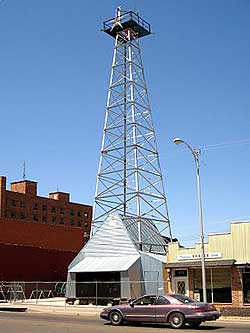
A downtown museum exhibits Borger’s oil heritage. Photo by Bruce Wells.
After establishing his Borger Townsite Company, Borger laid out streets and sold lots for the town, which grew to 15,000 residents in 90 days. When the oilfield produced large amounts of natural gas, the town named its minor league baseball team the Borger Gassers. The team left the league in 1955 (owners blamed air-conditioning and television for reducing attendance).
Dedicated in 1977, the Hutchinson County Boom Town Museum in Borger celebrates “Oil Boom Heritage” every March.
January 12, 1904 – Henry Ford sets Speed Record
Seeking to prove his cars were built better than most, Henry Ford set a world land speed record on a frozen Michigan lake. At the time his Ford Motor Company was struggling to get financial backing for its first car, the Model T. It was just four years after America’s first auto auto show.
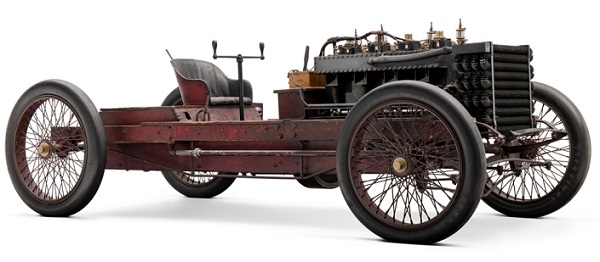
The Ford No. 999 used an 18.8 liter inline four-cylinder engine to produce up to 100 hp. Image courtesy Henry Ford Museum.
Ford drove his No. 999 Ford Arrow across Lake St. Clair, which separates Michigan and Ontario, Canada, at a top speed of 91.37 mph. The frozen lake “played an important role in automobile testing in the early part of the century,” explained Mark DIll in “Racing on Lake St. Clair” in 2009. “Roads were atrocious and there were no speedways.”
Learn about a 1973 natural gas-powered world speed record in Blue Flame Natural Gas Rocket Car.
January 12, 1926 – Texans patent Ram-Type Blowout Preventer
Seeking to end dangerous and wasteful oil gushers, James Abercrombie and Harry Cameron received a patent for a hydraulic ram-type blowout preventer (BOP). About four years earlier, Abercrombie had sketched out the design on the sawdust floor of Cameron’s machine shop in Humble, Texas. Petroleum companies embraced the new technology, which would be improved in the 1930s.
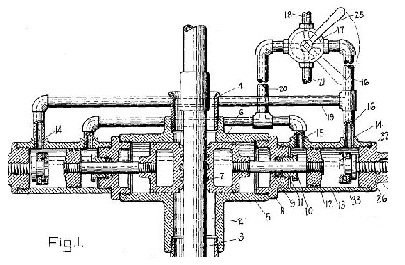
James Abercrombie’s design used hydrostatic pistons to close on the drill stem. His improved blowout preventer set a new standard for safe drilling
First used during the Oklahoma City oilfield boom, the BOP helped control production of the highly pressurized Wilcox sandstone (see World-Famous “Wild Mary Sudik”). The American Society of Mechanical Engineers recognized the Cameron Ram-Type Blowout Preventer as an “Historic Mechanical Engineering Landmark” in 2003.
Learn more in Ending Oil Gushers – BOP.
January 14, 1928 – Illustrating Ads for Standard Oil launches Career of Future Dr. Seuss
New York City’s Judge magazine published its first cartoon drawn by Theodor Seuss Geisel — who would develop his skills as “Dr. Seuss” while working for the Standard Oil Company of New Jersey.

Standard Oil’s “Flit” was a popular bug spray.
In the 1928 cartoon that launched his professional career as an advertising illustrator, Geisel drew a peculiar dragon trying to dodge Flit, a popular bug spray of the day. “Quick, Henry, the Flit!” soon became a catchphrase nationwide. Flit was one of Standard Oil of New Jersey’s many consumer products derived from petroleum.
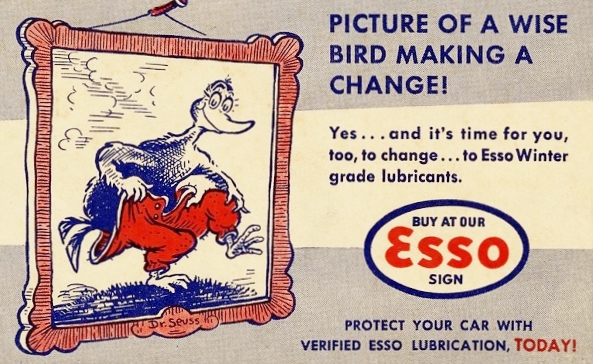
During the Great Depression, Theodor S. Geisel — Dr. Seuss — created popular advertising campaigns for the Standard Oil Company of New Jersey.
Throughout the Great Depression, hundreds of Geisel’s fanciful critters populated Standard Oil advertisements, providing him much-needed income. Advertising campaigns included cartoon creatures for Esso gasolines, lubricating oils, and Essomarine engine oil and greases. The famed children’s book author would later acknowledge this Standard Oil experience, “taught me conciseness and how to marry pictures with words.”
Learn more in Seuss I am, an Oilman.
January 14, 1954 – Oil discovery in South Dakota
A Shell Oil Company wildcat well in Harding County, South Dakota, began producing oil from about 9,300 feet deep, revealing South Dakota’s first oilfield. Drilled in what proved to be the Buffalo field, the well produced more than 341,000 barrels of oil in five decades.
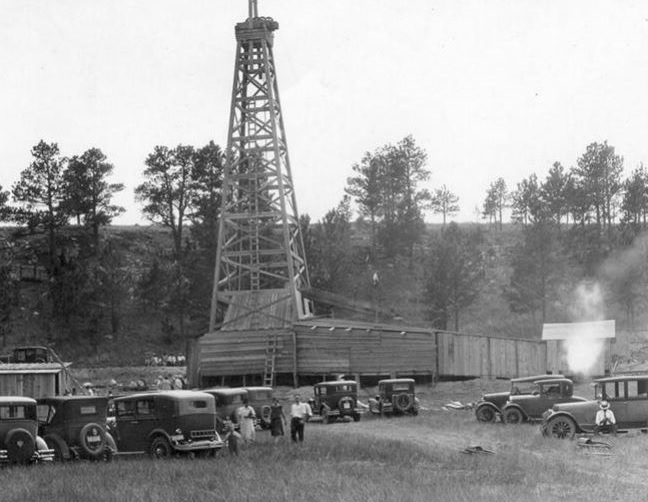
A wooden cable-tool rig in 1929 drilled a “dry hole” in Custer County of the “Mount Rushmore State.” Photo courtesy South Dakota Department of Environment and Natural Resources.
Although South Dakota had a long history of petroleum exploration (natural gas production began in 1899), Harding County produced most of the state’s oil. Since the 1980s, South Dakota oil production has ranged between about 1 million and 2 million barrels of oil per year, according to the U.S. Energy Information Agency (EIA).
Although modern Bakken shale production does not extend into South Dakota, exploration companies have found other oil-producing formations (also see First North Dakota Oil Well).
_______________________
Recommended Reading: Giant Under the Hill: A History of the Spindletop Oil Discovery at Beaumont, Texas, in 1901 (2008); Early Louisiana and Arkansas Oil: A Photographic History, 1901-1946
(1982); I Invented the Modern Age: The Rise of Henry Ford
(2014); Drilling Technology in Nontechnical Language
(2012); Theodor Geisel: A Portrait of the Man Who Became Dr. Seuss
(2010). Your Amazon purchase benefits the American Oil & Gas Historical Society. As an Amazon Associate, AOGHS earns a commission from qualifying purchases.
_______________________
The American Oil & Gas Historical Society (AOGHS) preserves U.S. petroleum history. Become an AOGHS annual supporting member and help maintain this energy education website and expand historical research. For more information, contact bawells@aoghs.org. Copyright © 2024 Bruce A. Wells. All rights reserved.




